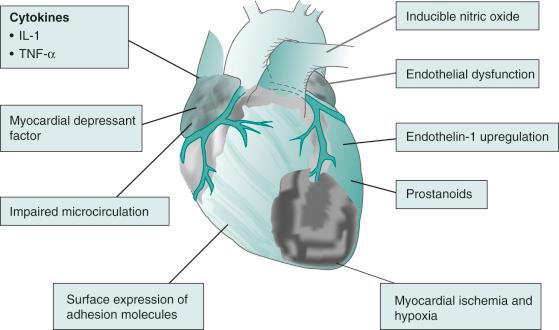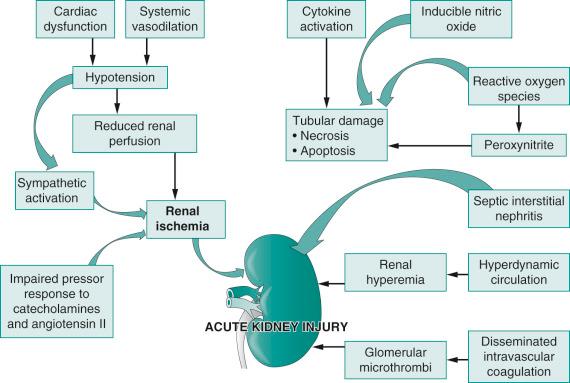Physical Address
304 North Cardinal St.
Dorchester Center, MA 02124
The chapter will:
Describe epidemiology, pathophysiology, diagnosis, and main clinical features of cardiorenal syndrome type 5 (CRS-5).
Review main clinical disease leading to CRS-5 development.
Identify widespread treatment guidelines in CRS-5 patients.
The cardiorenal syndromes (CRS) recently have been defined systematically as disorders of heart or kidney whereby one organ dysfunction leads to dysfunction of another. Five types of CRS are defined. The first four types describe acute or chronic cardiorenal or renocardiac syndromes. Type 5 CRS (CRS-5) refers to secondary cardiorenal syndrome or cardiorenal involvement in systemic conditions. It is a clinical and pathophysiologic entity to describe the concomitant presence of renal and cardiovascular dysfunction. CRS-5 can be acute or chronic ( Table 115.1 ), and it does not satisfy strictly the definition of CRS. However, it encompasses many conditions in which combined heart and kidney dysfunction is observed. Because this entity was described recently, there is limited information about the epidemiology, clinical course, and treatment of this condition.
| ACUTE CRS-5 | CHRONIC CRS-5 |
|---|---|
| Sepsis | Diabetes mellitus |
| Infections (malaria, leptospira, HIV, parvovirus b19, cytomegalovirus, coxsackievirus, toxoplasmosis) | Hypertension |
| Connective tissue disorders | Tuberculosis |
| Electric shock | Sarcoidosis |
| Drugs (cocaine, heroin, calcium channel blockers, cisplatin, methotrexate, mitomycin) | Fabry disease |
| Thrombotic microangiopathy | SLE (systemic lupus erythematosus) |
| Toxins (arsenic, snake bite, scorpion bite) | Chronic liver disease |
| Wegener granulomatosis | Sickle cell disease |
| Pheochromocytoma | Multiple myeloma |
| Burkitt lymphoma | Amyloidosis |
All vital organs of the body share biologic information, also termed as organ cross-talk. The normal physiologic functions of the body depend on this normal network. One organ dysfunction can result in dysfunction of another. The interaction between the heart and the kidney is fairly common. Heart and kidney dysfunction can be observed in many hospitalized patients, especially in the intensive care unit. Over the last decade, many intensivists, cardiologists, and nephrologists have shown keen interest in pathophysiology of this organ cross-talk between the heart and kidney. Many terms for this organ cross-talk have been suggested, such as cardiorenal anemia syndrome, cardiorenal syndrome, and renocardiac syndrome. Until recently CRS was not defined. Ronco et al. have proposed the definition and subdivision of CRS into five subtypes. Irrespective of the first insult (heart failure causing kidney injury or renal failure causing heart disease), CRS portends increased mortality and morbidity. CRS-5 is a recently defined clinical syndrome, and complete epidemiologic data on this entity are still incomplete.
Inflammation and microvasculature alterations form a basis to the pathogenesis for involvement of the kidneys and cardiovascular system during sepsis, leading to cell ultrastructural alterations and organ dysfunction. The cardiovascular system frequently is involved in sepsis and always is affected by septic shock. Cardiovascular dysfunction in sepsis is associated with a significantly increased mortality rate of 70% to 90% compared with 20% in patients without cardiovascular impairment. Myocardial dysfunction in sepsis has been the focus of intense research. Many mediators and pathways ( Fig. 115.1 ) have been implicated in pathogenesis of septic myocardial depression; however, the precise etiopathogenesis is unclear. Calvin et al. were the first to demonstrate myocardial dysfunction in adequately volume-resuscitated septic patients with decreased ejection fraction and increased end-diastolic volume index. Echocardiographic studies have demonstrated impaired left ventricular systolic and diastolic function in septic patients. Many other studies have confirmed decreased contractility and impaired myocardial compliance in sepsis.

Septic cardiac dysfunction is multifactorial. Like septic AKI, ischemia and inflammatory mediators are the chief culprits. Global myocardial ischemia was postulated initially as a the main mechanism of cardiac dysfunction, but later septic patients have been shown to have high coronary blood flow and diminished coronary artery–coronary sinus oxygen difference. Further experiments suggested a possibility of myocardial hypoxia resulting from alterations in coronary blood flow and myocardial metabolism as a possible mechanism of cardiac dysfunction. In patients with underlying coronary artery disease, myocardial ischemia is aggravated.
Inflammatory mediators also play a key role in the pathogenesis of cardiac dysfunction. Tumor necrosis factor (TNF) and interleukin-1 (IL-1) are the principal culprits. Elevated levels of prostanoids such as thromboxane and prostacyclin, which may alter coronary autoregulation and endothelial function also have been demonstrated in septic patients. One of these cytokines also may act as a myocardial depressant factor.
Nitric oxide (NO) has important biologic role in cardiovascular system. Higher dose of NO has been demonstrated to induce myocardial dysfunction by depressing energy generation. Sepsis leads to the expression of inducible NOS (iNOS) in the myocardium, which in turn importantly leads to myocardial dysfunction.
Acute kidney injury (AKI) is a common complication of patients with sepsis and carries poor prognosis. AKI occurs in 20% of critically ill patients and in 51% of patients with septic shock and with positive blood cultures. The mortality rate of sepsis-induced AKI is high, at approximately 70%, whereas the mortality of AKI alone is 40% to 45%. Although the presence of multiple organ dysfunction and other comorbidities contributes to high mortality, AKI independently increases morbidity and mortality. Sepsis is characterized by a generalized inflammatory response and by activation of coagulation and fibrinolytic system, resulting in endothelial injury. Current opinion suggests that pathogenesis of septic AKI relies on hemodynamic factors and inflammatory mediators ( Fig. 115.2 ). AKI in sepsis earlier was considered to be secondary to renal ischemia because of septic shock. Experimental studies of septic AKI have reported conflicting results. On one hand, some studies showed that global renal blood flow (RBF) declines after induction of sepsis or endotoxemia, leading to acute tubular necrosis, reduction in glomerular filtration, and severe AKI. On the other hand, Ravikant demonstrated renal vasodilation with increased RBF. A meta-analysis of 160 experimental sepsis studies found preserved or increased RBF in about 30% those studies. Changes in intrarenal hemodynamics also play a role in the pathogenesis of septic AKI. The RBF may be redistributed preferentially to the cortex, causing a relative hypoxia of medulla.

Nonhemodynamic kidney injury is mediated by various inflammatory mediators such as cytokines, arachidonate metabolites, and vasoactive and thrombogenic agents. These various mediators are involved in the pathogenesis of organ dysfunction in sepsis. Among the variety of mediators TNF seems to have the predominant role in septic AKI. Apoptosis seems to be an important pathway of cell dysfunction in sepsis than necrosis. All in all, there is a recent paradigm shift in understanding about the pathogenesis of septic AKI from ischemia and vasoconstriction to hyperemia and vasodilation and from acute tubular necrosis to acute tubular apoptosis.
The systemic amyloidoses are an uncommon group of disorders characterized by the extracellular deposition of amyloid in one or more organs. Cardiac and renal deposition leading to restrictive cardiomyopathy and proteinuric renal disease is a common feature of amyloidosis. Importantly, presence and severity of CRS drives the prognosis of systemic amyloidosis.
Among many types of amyloidoses, AL (primary) and AA (secondary) amyloidosis are the types most frequently encountered in clinical practice. AL amyloidosis, in which amyloid is derived from monoclonal light chains, is associated with clinical cardiac involvement in about 50% of all cases. Subclinical cardiac involvement at autopsy or on endomyocardial biopsy may be detected in almost all patients. Renal involvement occurs in 30% to 40% of all AL cases. On the contrary, AA type is characterized by predominant renal involvement in 60% to 100% of all cases. Cardiac involvement is less frequent and varies from 0 to 39.5%.
In amyloidosis, the heart demonstrates thickening of all four chambers, with biatrial dilation, mildly dilation of right ventricle with normal or small left ventricular cavity. Myocardial cells are separated by amyloid deposits with infiltration of intramyocardial vessels. Occasionally epicardial coronary vessels also are involved, leading to myocardial ischemia. The conduction system is involved frequently. The predominant manifestation of amyloid heart disease is congestive heart failure. In patients with small vessel involvement and minimal or no myocardial infiltration, the presenting complaint may be angina. In addition, atrial arrhythmias are seen frequently.
Renal amyloid is characterized by deposits in the glomerular basement membrane, the subendothelial area, and the extracellular mesangial system. Occasionally tubular deposits are seen. The majority of patients with renal amyloidosis present with proteinuria, which can vary from minimal asymptomatic proteinuria to nephrotic syndrome. Hematuria is present in about one third of patients. Chronic renal insufficiency with little proteinuria also can be seen in patients with extensive vascular deposits. In patients with tubular deposits, tubular dysfunction can be seen.
Become a Clinical Tree membership for Full access and enjoy Unlimited articles
If you are a member. Log in here